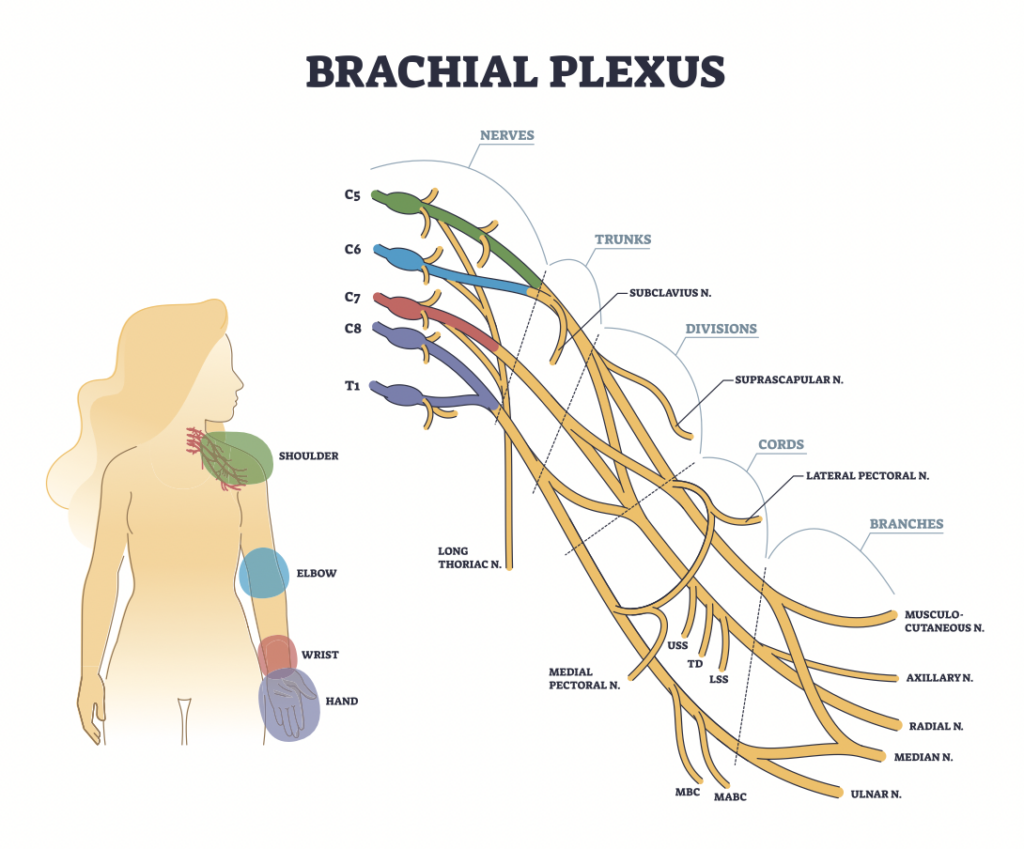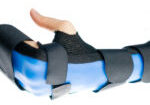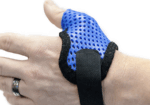Comparison of Erb’s Palsy and Klumpke’s Palsy: Symptoms, Presentation, and Treatment Options
Filed under Treatments
What is the brachial plexus?
The brachial plexus is a group of nerves originating from the cervical and thoracic nerve roots (from C5 to T1). The brachial plexus forms 5 peripheral nerves of the upper extremity, consisting of the musculocutaneous, median, radial, ulnar, and axillary nerves. This group of nerves supplies motor and sensory innervation to the entirety of the upper extremity.
How do injuries happen?
Brachial plexus injuries have multiple mechanisms of injury in infants. These injuries can be caused by compression, traction, stretching, rupture, or avulsion of the nerves of infants during childbirth. Larger infants are at a higher risk of brachial plexus injuries due to the risk of shoulder dystocia (the shoulder of the fetus gets stuck on the pelvis during childbirth). Injuries can also be caused by breech presentation at birth, uterine abnormalities such as uterine fibroids, or the fetus being in a transverse position for a prolonged period of time.
Erb’s palsy vs. Klumpke’s palsy
Erb’s palsy is an upper brachial plexus injury from C5-C6 (sometimes involving C7), while Klumpke’s palsy is a lower brachial plexus injury from C8-T1 (sometimes C7 is involved as well). Erb-Klumpke’s (total paralysis) can also occur if the entirety of the brachial plexus is involved with the injury (C5-T1).
Erb’s palsy causes weakness or paralysis of muscles of the upper arm and shoulder, presenting as the internal rotation of the forearm and flexion of the wrist and fingers with the arm hanging, also called waiter’s tip deformity. Klumpke’s palsy involves weakness or paralysis of the muscles of the forearm and hand, commonly presenting as a “claw hand” with the forearm in supination and flexion of the wrist and fingers.
How are they treated?
Many cases of brachial plexus injuries recover independently with time; however, nonsurgical and surgical treatments are available. Therapy is a common form of treatment that promotes passive range of motion of the shoulder, elbow, wrist, and hand to avoid stiffness of joints. Parents are educated on exercises they can practice with their children at home. Surgery is also an option to repair any rupture present or perform a nerve transfer from another muscle to restore the function of the affected muscles if no progress has been made through the conservative route.

References:
Benjamin, K. (2005). PART 1. Injuries to the brachial plexus. Advances in Neonatal Care, 5 (4), 181-189. doi: 10.1016/j.adnc.2005.03.004.
Brachial plexus injury. Johns Hopkins Medicine. (2022, December 22). https://www.hopkinsmedicine.org/health/conditions-and-diseases/brachial-plexus-injuries
Erb’s palsy (brachial plexus birth palsy) – orthoinfo – AAOS. OrthoInfo. (n.d.). https://orthoinfo.aaos.org/en/diseases–conditions/erbs-palsy-brachial-plexus-birth-palsy/
Klumpke paralysis. Physiopedia. (n.d.). https://www.physio-pedia.com/Klumpke_Paralysis professional, C. C. medical. (n.d.). Shoulder dystocia: Signs, causes, prevention & complications. Cleveland Clinic. https://my.clevelandclinic.org/health/diseases/22311-shoulder-dystocia
More To Read
Factors that influence orthosis adherence in patients with acute traumatic tendon injuries to the hand
Savaş, S., & Aydoğan, Ç. (2020). Factors affecting orthosis adherence after acute traumatic hand tendon repairs: A prospective cohort study. Journal of Hand Therapy, S0894113020301848. https://doi.org/10.1016/j.jht.2020.10.005 World Health Organization. (2003). Adherence to long-term therapies: evidence for action. World Health Organization. The Skinny Adherence to orthosis wear is vital for protecting healing tendons after a traumatic tendon…
Read MoreEffectiveness of Conservative Therapy and Splinting for 1st CMC OA
Tsehaie, J., Sprekraijse, K., Wouters, R., Slijper, H., Feitz, R., Hovious, S., & Selles, R. (2018). Outcome of a Hand Orthosis and Hand Therapy for Carpometacarpal Osteoarthritis in Daily Practice: A Prospective Cohort Study. American Society for Surgery of the Hand, 1-11. The skinny: Non-surgical approaches (hand therapy & orthotics) are typically the go-to for…
Read MorePediatric & Adolescent Shoulder Instability
Lin, K.M, James, E.W., Spitze, E. & Fabricant, P.D. (2018). Pediatric and adolescent anterior shoulder instability: Clinical management of first-time dislocators. Current opinion in pediatrics, 30, 49-56. doi: 10.1097/MOP.0000000000000566. The Skinny: Shoulder instability for pediatric and adolescent patients is fairly common and is often complicated by a high re-dislocation rate. Shoulder instability typically occurs after…
Read MoreThumbs up for treating thumb pain in the hand therapy clinic
What do “Mommy’s thumb,” “gamer’s thumb,” and “radial styloid tenosynovitis” have in common? They are all officially called de Quervain’s tenosynovitis De Quervain’s involves the tendons within the first dorsal compartment, abductor pollicis longus (APL) and extensor pollicis brevis (EPB) and arises when the tendons are inflamed and are not able to move through the…
Read MoreSign-up to Get Updates Straight to Your Inbox!
Sign up with us and we will send you regular blog posts on everything hand therapy, notices every time we upload new videos and tutorials, along with handout, protocols, and other useful information.






